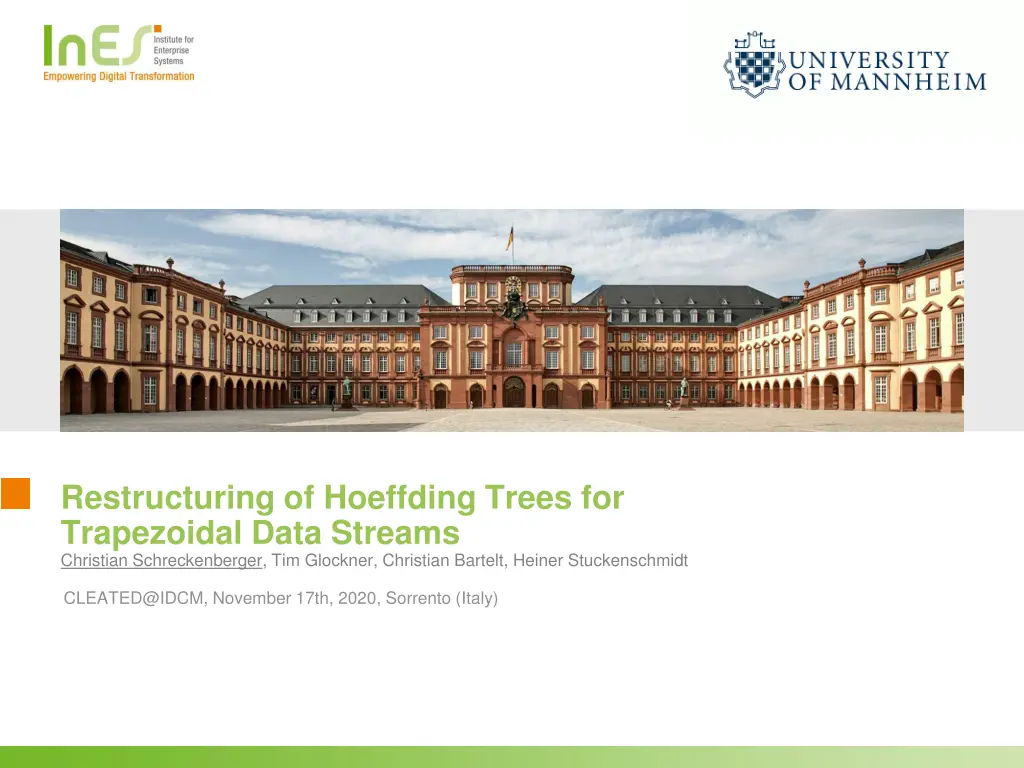
Restructuring of Hoeffding Trees for Trapezoidal Data Streams
Explore the restructuring of Hoeffding Trees for Trapezoidal Data Streams, focusing on dynamic decision trees, evaluation, and sensor networks. Learn about Trapezoidal Data Streams, Hoeffding Trees, Hoeffding Bound, and challenges with emerging features in this informative content.
Download Presentation

Please find below an Image/Link to download the presentation.
The content on the website is provided AS IS for your information and personal use only. It may not be sold, licensed, or shared on other websites without obtaining consent from the author. If you encounter any issues during the download, it is possible that the publisher has removed the file from their server.
You are allowed to download the files provided on this website for personal or commercial use, subject to the condition that they are used lawfully. All files are the property of their respective owners.
The content on the website is provided AS IS for your information and personal use only. It may not be sold, licensed, or shared on other websites without obtaining consent from the author.
E N D
Presentation Transcript
Restructuring of Hoeffding Trees for Trapezoidal Data Streams Christian Schreckenberger, Tim Glockner, Christian Bartelt, Heiner Stuckenschmidt CLEATED@IDCM, November 17th, 2020, Sorrento (Italy)
Outline Agenda 1. Introduction 2. Dynamic Fast Decision Tree 3. Evaluation 4. Conclusion 2
Outline Agenda 1. Introduction 2. Dynamic Fast Decision Tree 3. Evaluation 4. Conclusion 3
Sensor Networks as an Example of Time Evolving Data Sensor Networks are inherently evolving dynamically over time Data is recorded over time New sensors can and will be added over time Leading to new feature streams to emerge Data(streams) will be lost due to Sensors that break Sensor gets replaced Sensor does not get replaced Transmission failures 4
Trapezoidal Data Streams This work focusses on emerging features Problem was named Trapezoidal Data Streams Term introduced by Zhang et al. (2016) Increasing number of data instances Expanding feature space 5
Hoeffding Trees in a Nutshell The algorithm by Domingos (2000) induces decision trees from non trapezoidal data streams Main idea: Data instances are passed down the tree until a leaf is reached Each leaf stores data instances as counts in the so called n_ijk matrix. Once the Hoeffding bound is satisfied the respective leaf is split according to the best feature The Hoeffding tree algorithm can induce decision trees based on the Hoeffding bound in an online and memory efficient manner 6
Problems with Emerging Features Meaningful features will emerge Likely to induce splits in many leaves Makes the tree unecessarily big Needs a lot instances to reach each leaf Some decision nodes become redudant Which also increases the tree size unnecessarily 8
Outline Agenda 1. Introduction 2. Dynamic Fast Decision Tree 3. Evaluation 4. Conclusion 9
Approach The proposed algorithm Dynamic Fast Decision Trees takes key concepts from Hoeffding trees. Handling of emerging features: Tree is restructured on a predefined interval on a global scope: m Reordering of decision nodes from root to leaves based on information gain Pruning removes unnecessary decision nodes 10
Decision Matrix Matrix representing the structure of the decision tree Each column represents a binary decision Each row represents a leaf Combined with the array of leaves a full decision tree can be reconstructed 11
Restructuring Resulting in restructured tree with exact same decision matrix and leaves Making exactly the same predictions Decision nodes yielding little information gain close to the leaves Some of these decision nodes may yield no additional information gain 17
Information Gain Information gain has to be calculated when it is needed because of Statistical fluctuations Dependent features and can be performed through Selection of relevant leaves Aggregation of their statistics in n_ijk. 18
Pruning - Conditions Goal: Redundant decision nodes should be identified and replacedby a leaf node. Conditions: both children predict the same label Hoeffding bound evaluated with higher value for and true mean of 0 and IG(F) threshold of minimum numbers of samples seen in each leaf isreached 21
Pruning Both children are leaves: conditions specified are tested if satisfied, sample counts are aggregated into a new leaf and attached in place of that decision node otherwise, subtree is not pruned At least one child is a decision node: in a recursive manner, children that are not leaves are processed the same way this might lead to children being replaced by leaf nodes steps above are then applied to the decision node 22
Outline Agenda 1. Introduction 2. Dynamic Fast Decision Tree 3. Evaluation 4. Conclusion 24
Setting Data: synthetic data Approach: Comparison between VFDT and DFDT on different data sets With various parameter settings Samples were used to predict and measure accuracy and then fed to the learning algorithm 25
Outline Agenda 1. Introduction 2. Dynamic Fast Decision Tree 3. Evaluation 4. Conclusion 28
Conclusion We introduced a new algorithm to deal with trapezoidal data streams DFDT can deal better with parameters that increase the speed of the growth However, dropping decision nodes, also means dropping samples The best trees had relatively high values for rho Future Work Extend evaluation on real world data cases Force splits to be able to push up decision nodes even further Extend to dropping features, here restructuring may be beneficial over dropping whole subtrees 29
Q&A Any Questions? Get in Contact schreckenberger@es.uni- mannheim.de
